In 2025, electric off-road bikes combine advanced battery tech, such as higher energy density and fast-charging, with lightweight, durable designs made from carbon fiber and reinforced alloys. These bikes offer smooth, instant torque, quiet operation, and smart systems for diagnostics and customization. With the market trending toward sustainability and high performance, the latest innovations are changing how you experience off-road adventures. Keep exploring to discover what’s shaping the future of these powerful machines.
Key Takeaways
- Enhanced battery technology provides longer rides, faster charging, and improved safety with solid-state and lithium-polymer chemistries.
- Lightweight, durable frames made from advanced composites like carbon fiber boost off-road performance and handling.
- Growing market demand emphasizes customization, sustainability, and high-performance features for various trail and racing needs.
- Electric off-road bikes deliver instant torque, quiet operation, and simpler maintenance compared to traditional gas-powered models.
- Emerging trends include higher energy density batteries, smart diagnostics, and autonomous features improving user experience.
Innovations in Battery Technology and Power Management
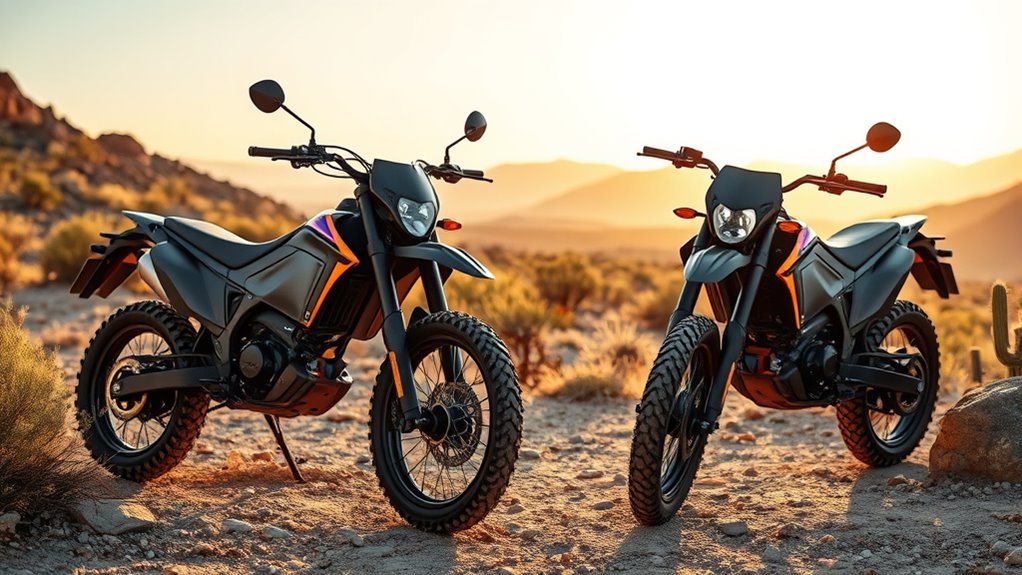
Recent advancements in battery technology and power management are transforming off-road electric bikes, making them more efficient and reliable. You’ll notice longer rides thanks to higher-capacity batteries that pack more energy into less space. Fast-charging capabilities mean you spend less time waiting and more time riding. Innovative battery chemistries, like solid-state and lithium-polymer, boost safety and longevity, reducing the risk of overheating or degradation. Power management systems now intelligently optimize energy use, ensuring you get maximum performance with minimal waste. Regenerative braking captures energy during descents, extending your ride time even further. These technological improvements give you greater confidence, knowing your bike can handle tough terrains while maintaining consistent power. As a result, off-road adventures become more accessible, exciting, and sustainable. Understanding battery chemistry advancements helps explain how these improvements are achieved and their impact on performance.
Design and Build: Lightweight Materials and Enhanced Durability
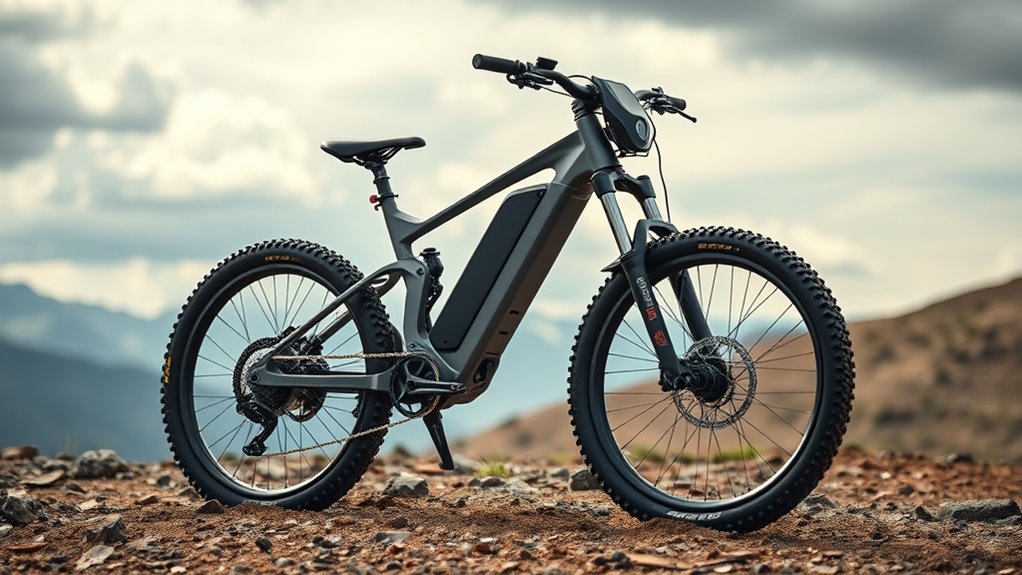
To excel in challenging off-road conditions, electric bikes now incorporate lightweight materials that reduce weight without sacrificing strength. You’ll find frames made from advanced composites like carbon fiber and reinforced aluminum alloys, which deliver durability while keeping the bike agile. These materials also help lower the overall weight, making handling easier on rugged terrain. Additionally, manufacturers focus on enhancing durability by using impact-resistant plastics and reinforced components that withstand rough trails and crashes. Precision engineering ensures parts like suspension forks, wheels, and protective panels are both lightweight and tough. Dog names are also carefully selected to reflect the bike’s style and personality, enhancing rider connection. This combination of materials allows you to ride longer distances, navigate obstacles more easily, and experience greater control. Ultimately, the design improvements enable a resilient, lightweight build that meets the demands of serious off-road adventures.
Market Dynamics and Consumer Preferences in 2025
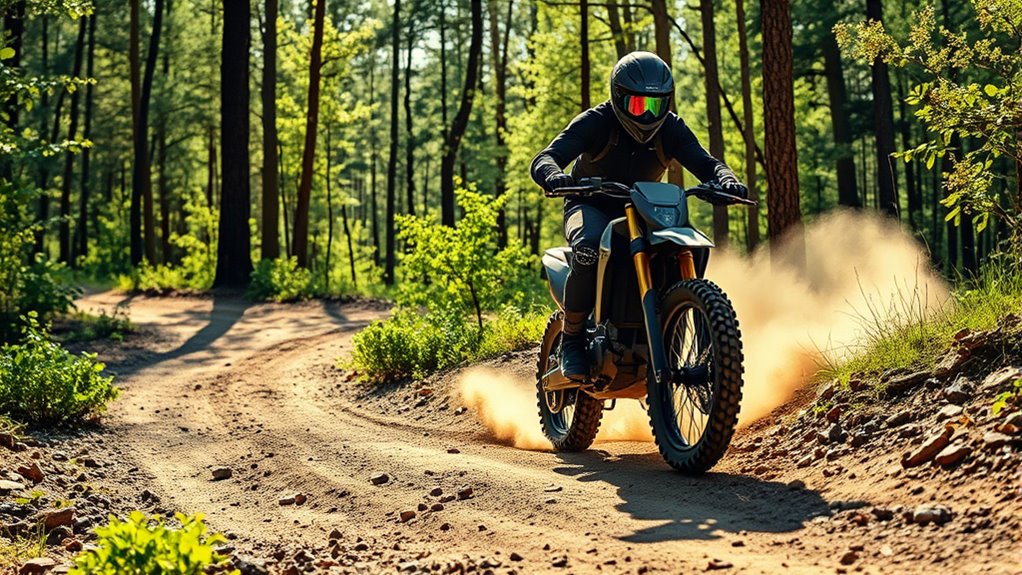
In 2025, the electric off-road bike market is experiencing rapid growth driven by increasing consumer demand for eco-friendly and high-performance alternatives to traditional motorcycles. You’re seeking bikes that combine power with sustainability, favoring models with longer battery life and faster charging. Consumers prioritize versatility, demanding bikes suited for trail riding, racing, and recreational use. There’s a strong preference for customization options, allowing riders to tailor bikes to their needs. Pricing remains a key factor, with affordability influencing adoption, but quality and brand reputation also matter. You’re increasingly aware of environmental impacts, making electric bikes your top choice for reducing carbon footprints. Overall, the market is driven by a blend of technological innovation, environmental consciousness, and a desire for exciting, reliable off-road experiences. The importance of natural materials in design is also growing, as consumers seek sustainable options that enhance durability and aesthetic appeal.
Comparing Electric and Traditional Gas-Powered Off-Road Bikes
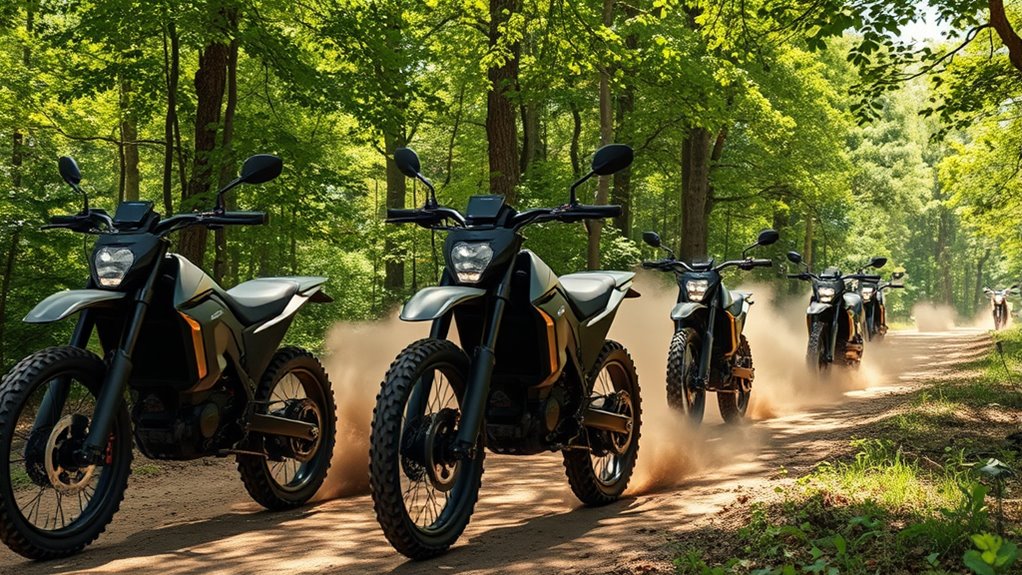
Electric off-road bikes are quickly gaining ground as a viable alternative to traditional gas-powered models, offering several advantages that appeal to riders seeking efficiency and sustainability. They deliver instant torque, providing quick acceleration and smooth handling on rough terrain. Maintenance is simpler, with fewer moving parts and no oil changes, saving you time and money. However, gas bikes often boast longer range and faster refueling, which matter during extended rides. Consider the key differences:
| Feature | Electric Bikes | Gas Bikes |
|---|---|---|
| Power Delivery | Instant torque, smooth acceleration | Gradual, engine-dependent power |
| Range | Limited, dependent on battery capacity | Longer, quick refueling |
| Maintenance | Low, fewer parts to service | Higher, regular oil and parts |
| Noise | Quiet operation | Loud, engine noise |
| Environmental Impact | Zero emissions | Emissions and fuel consumption |
Future Perspectives: Emerging Trends and Upcoming Technologies
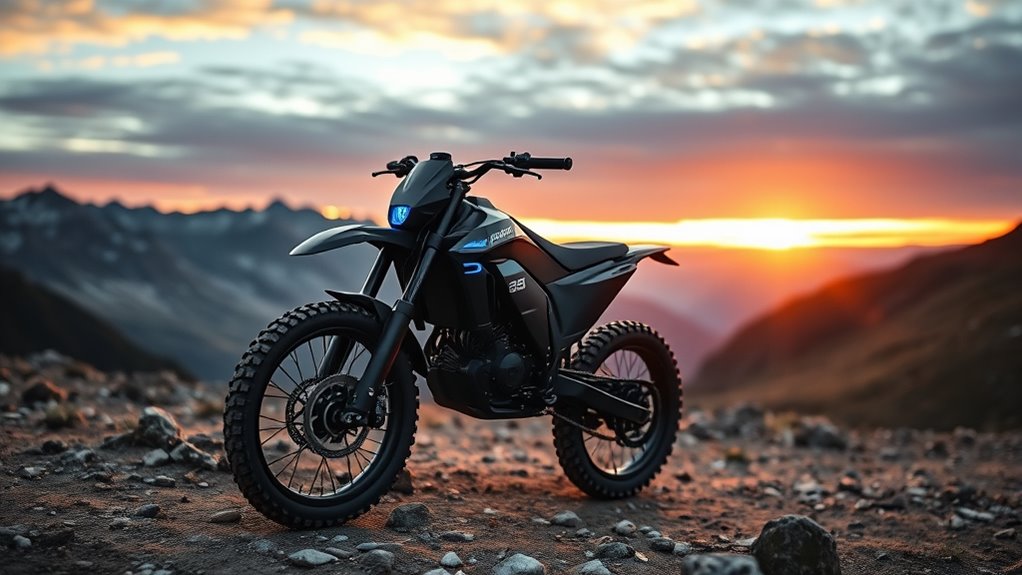
Advancements in battery technology and motor design are driving rapid innovation in electric off-road bikes, promising to further close the gap with traditional gas models. Expect batteries with higher energy density, enabling longer rides without adding weight, while faster charging options reduce downtime. Motor designs are becoming more efficient, lighter, and more powerful, enhancing performance and handling. Upcoming technologies like integrated smart systems will offer real-time diagnostics, personalized riding modes, and improved safety features. Manufacturers are also exploring lightweight frame materials and modular components for easier upgrades. Autonomous features, although still in early stages, could eventually assist riders or provide semi-autonomous navigation. Additionally, juice detox side effects and other health considerations remind us of the importance of balanced approaches to energy and recovery. Overall, these emerging trends will make electric off-road bikes more capable, durable, and user-friendly, transforming the riding experience in the near future.
Frequently Asked Questions
What Are the Safety Regulations for Electric Off-Road Bikes in Different Countries?
You should know that safety regulations for electric off-road bikes vary widely across countries. In some places, you need to wear helmets and follow age restrictions, while others require registration or insurance. You’ll also find differing standards for power limits and noise levels. Always check local laws before riding, as compliance guarantees your safety and helps avoid fines or legal issues. Staying informed keeps your riding experience safe and enjoyable.
How Do Maintenance Costs Compare Between Electric and Gas-Powered Off-Road Bikes?
Imagine your off-road bike as a trusty steed — electric bikes are like low-maintenance ponies, while gas-powered ones need regular grooming. You’ll likely spend less on electric bike upkeep, with fewer moving parts and no oil changes. Data shows electric bikes can save owners up to 30% annually in maintenance costs. So, if you want to hit trails without constant repairs, electric is your smarter, easier choice.
Are There Specific Training Programs for New Electric Off-Road Bike Riders?
You’ll find that many brands and organizations now offer specific training programs for new electric off-road bike riders. These programs focus on safety, handling, and maintenance tailored to electric bikes’ unique features. Participating in such training helps you gain confidence and develop essential skills quickly. Whether through local clubs or online courses, these programs make sure you’re well-prepared to enjoy off-road riding safely and responsibly.
How Does Battery Recycling Impact Environmental Sustainability in 2025?
You might wonder how battery recycling influences environmental sustainability in 2025. When you recycle batteries, you help reduce the demand for raw materials, cut down on mining impacts, and lower toxic waste. This process keeps harmful substances out of landfills and conserves resources for future use. By supporting recycling efforts, you’re actively contributing to a cleaner planet and promoting sustainable practices in the growing electric off-road bike industry.
What Are the Insurance Considerations for Electric Off-Road Bike Owners?
Did you know that over 60% of off-road bike accidents involve rider injury? When insuring your electric off-road bike, you should consider coverage for theft, damage, and liability. Many policies now include protection against environmental damage and vandalism. Make sure to check if your policy covers off-road use specifically, as some standard plans don’t. Proper insurance gives you peace of mind, so you can enjoy your rides safely and responsibly.
Conclusion
By 2025, electric off-road bikes will totally revolutionize your riding experience, making gas-powered bikes look like ancient relics. With cutting-edge battery tech, super-light frames, and crazy durability, you’ll feel unstoppable on any trail. The market’s buzzing with new preferences, and upcoming tech promises even more jaw-dropping innovations. Get ready—your next adventure is about to become way faster, cleaner, and way more exciting than you ever imagined!









